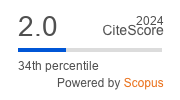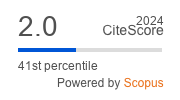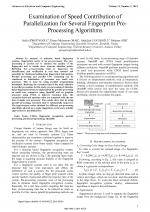| 2/2014 - 1 | View TOC | « Previous Article | Next Article » |
Examination of Speed Contribution of Parallelization for Several Fingerprint Pre-Processing AlgorithmsGORGUNOGLU, S. |
| Extra paper information in |
| Click to see author's profile in |
| Download PDF |
Author keywords
CUDA, fingerprint recognition, parallel processing, parallel programming, OpenMP
References keywords
image(11), fingerprint(10), processing(6), algorithm(6), pattern(4), minutiae(4)
Blue keywords are present in both the references section and the paper title.
About this article
Date of Publication: 2014-05-31
Volume 14, Issue 2, Year 2014, On page(s): 3 - 8
ISSN: 1582-7445, e-ISSN: 1844-7600
Digital Object Identifier: 10.4316/AECE.2014.02001
Web of Science Accession Number: 000340868100001
SCOPUS ID: 84901844580
Abstract
In analysis of minutiae based fingerprint systems, fingerprints needs to be pre-processed. The pre-processing is carried out to enhance the quality of the fingerprint and to obtain more accurate minutiae points. Reducing the pre-processing time is important for identification and verification in real time systems and especially for databases holding large fingerprints information. Parallel processing and parallel CPU computing can be considered as distribution of processes over multi core processor. This is done by using parallel programming techniques. Reducing the execution time is the main objective in parallel processing. In this study, pre-processing of minutiae based fingerprint system is implemented by parallel processing on multi core computers using OpenMP and on graphics processor using CUDA to improve execution time. The execution times and speedup ratios are compared with the one that of single core processor. The results show that by using parallel processing, execution time is substantially improved. The improvement ratios obtained for different pre-processing algorithms allowed us to make suggestions on the more suitable approaches for parallelization. |
| References | | | Cited By «-- Click to see who has cited this paper |
| [1] A. Venckauskas, N. Morkevicius, K. Kulikauskas, "Study of finger vein authentication algorithms for physical access control", Elektronika Ir Elektrotechnika (Electronics and Electrical Engineering), vol. 121, no. 5, pp. 101-104, 2012. [CrossRef] [Web of Science Times Cited 5] [SCOPUS Times Cited 4] [2] S. Gorgunoglu, A. Cavusoglu, "A Fast and Simple Algorithm for Fingerprint Segmentation", Engineering Science and Technology an International Journal (JESTECH) (formerly TEKNOLOJI), vol. 11, no. 2, pp. 87-92, 2008. [3] B. M. Mehtre, B. Chatterjee, "Segmentation of fingerprint images-A composite method", Pattern Recognition, vol. 22, no.4, pp. 381-385, 1989. [CrossRef] [Web of Science Times Cited 90] [SCOPUS Times Cited 145] [4] L. Hong, Y. Wan, A. Jain, "Fingerprint image enhancement: algorithm and performance evaluation", IEEE Transactions on Pattern Analysis and Machine Intelligence, vol. 20, no. 8, pp. 777-789, 1998. [CrossRef] [Web of Science Times Cited 1259] [SCOPUS Times Cited 1798] [5] A. Cavusoglu, S. Gorgunoglu, "A fast fingerprint image enhancement algorithm using a parabolic mask", Computers & Electrical Engineering, vol. 34, no. 3, pp. 250-256, 2008. [CrossRef] [Web of Science Times Cited 13] [SCOPUS Times Cited 20] [6] S. W. Smith, The Scientist and Engineer's Guide to Digital Signal Processing, San Diego: California Technical Publishing, pp. 436-442, 1999. [7] V. Espinosa-Duro, "Fingerprints thinning algorithm", Aerospace and Electronic Systems Magazine IEEE, vol. 18, no. 9, pp. 28-30, 2003. [CrossRef] [Web of Science Times Cited 13] [SCOPUS Times Cited 21] [8] M. Tico, P. Kuosmanen, "An algorithm for fingerprint image postprocessing", Thirty-Fourth Asilomar Conference on Signals, Systems and Computers, vol. 2, pp. 1735 - 1739, 2000. [CrossRef] [9] Q. Xiao, H. Raafat, "A combined statistical and structural approach for fingerprint", IEEE International Conference on image postprocessing, Systems, Man and Cybernetics, 331-335, 1990. [CrossRef] [Web of Science Times Cited 2] [10] J. C. Amengual, A. Juan, J. C. Perez, F. Prat, S. Saez, J. M. Vilar, "Real-time minutiae extraction in fingerprint images", Sixth International Conference on Image Processing and Its Applications, vol. 2, pp. 871 - 875, 1997. [CrossRef] [SCOPUS Times Cited 25] [11] S. Kasei, M. Deriche, B. Boashash, "Fingerprint Minutiae Exraction using block-direction on reconstructed images", TENCON '97. IEEE Region 10 Annual Conference. Speech and Image Technologies for Computing and Telecommunications, vol. 1, pp. 303-306, 1997. [CrossRef] [12] Z. Shi, V. Govindaraju, "A chaincode based scheme for fingerprint minutiae exraction", Pattern Recognition Letters, vol. 27, no. 5, pp. 462-468, 2006. [CrossRef] [Web of Science Times Cited 26] [SCOPUS Times Cited 48] [13] M. Gamassi, V. Piuri, F. Scotti, "Fingerprint local analysis for high-performance minutiae extraction", IEEE International Conference on Image Processing ICIP 2005, vol. 3, pp. III - 265-8, 2005. [CrossRef] [SCOPUS Times Cited 19] [14] T. Xionggang, C. Jun, "Paralel Image Processing with OpenMP", The 2nd IEEE International Conference on Information Management and Engineering (ICIME), pp. 20-23, 2010. [CrossRef] [SCOPUS Times Cited 3] [15] Y. Liu, F. Gao, "Parallel implementations of image processing algorithms on multi core", Fourth Internatinal Conference on Genetic and Evolutionary Computing, pp.71-74, 2010. [CrossRef] [SCOPUS Times Cited 7] [16] E. Ramaraj, A. S. Rajan, "Median filter using open multiprocessing in agriculture", IEEE 10th International Conference on signal processing ICSP2010, pp. 42-45, 2010. [CrossRef] [SCOPUS Times Cited 2] [17] H. Cao, X. Gu, "OpenMP Parallelization of Jacquin Fractal Image Encoding", 2010 International Conference on E-Product E-Service and E-Entertainment (ICEEE), pp. 1-4, 2010. [CrossRef] [SCOPUS Times Cited 3] [18] S. Park, S. Ponce, J. Huang, Y. Cao, F. Quek, "Low-Cost, High Speed Computer Vision Using NVIDIA's CUDA Architecture", 37th IEEE Applied Imagery Pattern Recognition Workshop, 1-4 (2008) [CrossRef] [SCOPUS Times Cited 28] [19] L. Pan, L. Gu, J. Xu, "Implementation of Medical Image Segmentation in CUDA", Proceedings of the 5th International Conference on Information Technology and Application in Biomedicine, 1-2 (2008) [CrossRef] [SCOPUS Times Cited 50] [20] CUDA Programming Guide Version 4.2. NVIDIA Corporation Santa Clara, California, 4-12 (2012) [21] Y. Li, K. Zhao, X. Chu, J. Liu, "Speeding up k-Means algorithm by GPUs", Journal of Computer and System Sciences, vol. 79, pp. 216-229, 2013. [CrossRef] [Web of Science Times Cited 48] [SCOPUS Times Cited 68] [22] S. Akhter, J. Roberts, Multi-Core Programming, Intel Press, Hillsboro, pp. 13-14, 2006. Web of Science® Citations for all references: 1,456 TCR SCOPUS® Citations for all references: 2,241 TCR Web of Science® Average Citations per reference: 63 ACR SCOPUS® Average Citations per reference: 97 ACR TCR = Total Citations for References / ACR = Average Citations per Reference We introduced in 2010 - for the first time in scientific publishing, the term "References Weight", as a quantitative indication of the quality ... Read more Citations for references updated on 2025-06-02 08:23 in 124 seconds. Note1: Web of Science® is a registered trademark of Clarivate Analytics. Note2: SCOPUS® is a registered trademark of Elsevier B.V. Disclaimer: All queries to the respective databases were made by using the DOI record of every reference (where available). Due to technical problems beyond our control, the information is not always accurate. Please use the CrossRef link to visit the respective publisher site. |
Faculty of Electrical Engineering and Computer Science
Stefan cel Mare University of Suceava, Romania
All rights reserved: Advances in Electrical and Computer Engineering is a registered trademark of the Stefan cel Mare University of Suceava. No part of this publication may be reproduced, stored in a retrieval system, photocopied, recorded or archived, without the written permission from the Editor. When authors submit their papers for publication, they agree that the copyright for their article be transferred to the Faculty of Electrical Engineering and Computer Science, Stefan cel Mare University of Suceava, Romania, if and only if the articles are accepted for publication. The copyright covers the exclusive rights to reproduce and distribute the article, including reprints and translations.
Permission for other use: The copyright owner's consent does not extend to copying for general distribution, for promotion, for creating new works, or for resale. Specific written permission must be obtained from the Editor for such copying. Direct linking to files hosted on this website is strictly prohibited.
Disclaimer: Whilst every effort is made by the publishers and editorial board to see that no inaccurate or misleading data, opinions or statements appear in this journal, they wish to make it clear that all information and opinions formulated in the articles, as well as linguistic accuracy, are the sole responsibility of the author.



